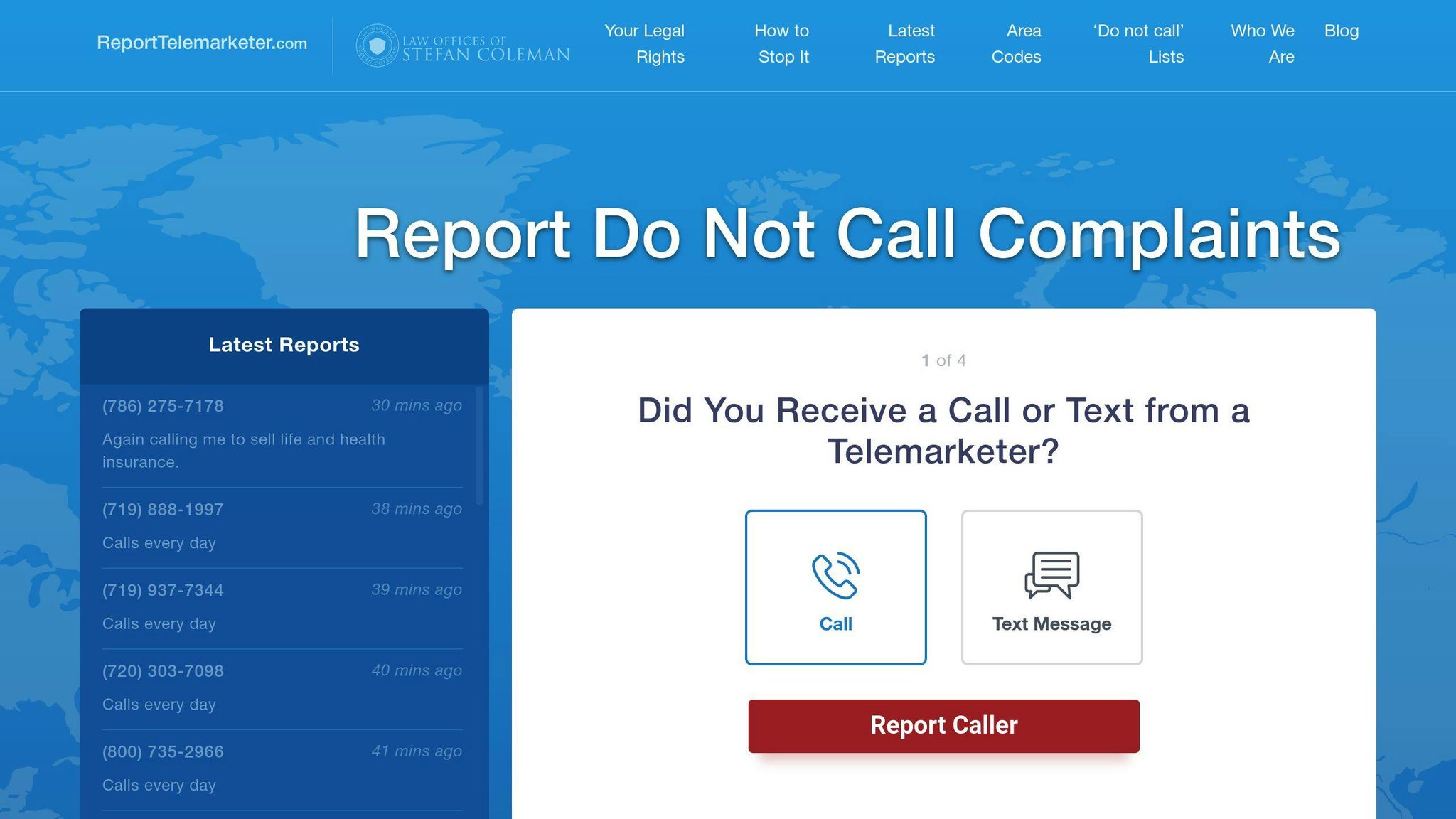
Wrong number spam calls are more than just a nuisance – they’re a growing scam tactic. Americans now face an average of 31 spam calls monthly, with 15% involving the wrong number ploy. These calls often start innocently, like a mistaken inquiry about "John’s car warranty", but their goal is to exploit trust and cause harm.
Key Takeaways:
- Impact: 17% of victims report anxiety about phone use; 8% lose an average of $1,200.
- Spotting Scams: Look for urgency, fake government claims, or pre-recorded messages.
- Protection Steps:
- Don’t engage with unknown callers.
- Document call details (date, time, number).
- Report calls to the FTC or platforms like ReportTelemarketer.com.
- Your Rights: Under the TCPA, you can claim $500–$1,500 per violation if spam calls persist after warning them.
Pro Tip: Use spam-blocking tools like T-Mobile’s Scam Shield or Verizon’s Call Filter to reduce unwanted calls. Protect your number by limiting its exposure online and using secondary numbers for public activities.
Learn how to identify, report, and seek compensation for these calls while safeguarding your privacy.
Identifying and Handling Wrong Number Spam Calls
How to Spot Spam Calls
Wrong number spam calls have become increasingly tricky, but they often follow recognizable patterns. Based on recent data, these calls share common traits that can help you identify them.
Here are some telltale signs of a spam call:
- Claims of being from government agencies like the IRS
- Pre-recorded messages asking you to "press 1" to continue
- Callers creating a false sense of urgency about payments or accounts
- Requests for immediate financial decisions
- Repeated calls from numbers that are slightly different
One scam that gained attention in 2024 is the "Can you hear me?" trick. Scammers record your "yes" response to use as fake authorization for charges. T-Mobile’s Scam Shield service reported blocking over 41 billion scam calls in 2024, thanks to AI-powered tools designed to detect these scams.
If you document these patterns, you can use them as evidence for potential TCPA claims.
Steps to Take When Receiving a Spam Call
If you suspect a wrong number spam call, acting quickly and carefully is key. Here’s what experts suggest:
1. Don’t Engage
Avoid interacting with the caller. Even a simple response confirms your number is active. The FBI warns that engaging can increase your chances of receiving more spam calls by up to 40%.
2. Keep a Record
Document details such as:
- The date and time of the call
- Caller information
- Any key points from the conversation
3. Report and Block
Take these steps to protect yourself:
- Block the number using your phone’s built-in features
- Report the call to ReportTelemarketer.com, which may help you seek compensation
- File a complaint with the FTC at donotcall.gov
- Use your carrier’s spam protection tools, like T-Mobile Scam Shield
"The most effective defense against wrong number spam calls is to treat every unexpected call as potentially fraudulent until proven otherwise", says Stefan Coleman, founder of ReportTelemarketer.com.
Your Rights Under the TCPA
Overview of the TCPA
The Telephone Consumer Protection Act (TCPA), passed in 1991, protects you from unwanted telemarketing calls. Here’s what the law prohibits:
- Using automated systems or prerecorded messages to call your phone without your consent.
- Making telemarketing calls outside the hours of 8 a.m. to 9 p.m. local time.
- Continuing to call after being told they have the wrong number.
- Contacting numbers registered on the National Do Not Call Registry.
For wrong number calls, the rule is straightforward: once you inform telemarketers they’ve reached the wrong number, they must stop calling. Any calls after this warning break TCPA regulations.
If these rules are violated, you have the right to take action. Let’s look at how compensation works.
Compensation for TCPA Violations
If you’ve been documenting wrong number calls as described in earlier sections, you’re in a strong position to seek compensation. Keeping accurate records is key to building your case.
Here’s a breakdown of potential compensation:
| Violation Type | Compensation Amount |
|---|---|
| Standard Violation | Up to $500 per call |
| Willful Violation | Up to $1,500 per call |
| Multiple Violations | Total amount for each call |
To strengthen your claim:
- Log details of every call.
- Clearly inform the caller they have the wrong number.
- Keep evidence of continued calls after your warning.
- Submit your complaint through platforms like ReportTelemarketer.com.
Proper documentation can make all the difference in ensuring your claim is successful.
Reporting Spam Calls and Seeking Compensation
Using ReportTelemarketer.com

If you’ve documented spam call violations that align with TCPA rules, ReportTelemarketer.com provides a simple way to seek compensation. The platform uses the protections offered by the TCPA to help users file claims effectively.
Here’s what makes the platform stand out:
- Expert investigation of possible violations
- No upfront fees for users
- Access to skilled attorneys specializing in telemarketing laws
How to Report Spam Calls
To report spam calls, use the call records you’ve maintained (as outlined in the earlier section, ‘Steps to Take When Receiving a Spam Call’). When submitting your case on ReportTelemarketer.com, it’s crucial to include detailed information to support your claim:
| Required Information | Why It’s Important |
|---|---|
| Caller’s Phone Number | Identifies the telemarketer |
| Date and Time | Helps establish a pattern of violations |
| Company Name | Links calls to specific businesses |
| Call Type | Categorizes the type of TCPA violation |
| Prior Communications | Shows if you requested the calls to stop |
Once you’ve gathered all these details, submit them through the platform’s secure form. Accuracy is key here – strong evidence increases your chances of compensation.
What Happens After Reporting a Call
Once your report is submitted, the platform begins a detailed investigation, building on the call records you’ve already collected. Here’s how the process works:
1. Initial Review
Your report is checked against known violator databases and TCPA compliance standards. This automated step quickly flags potential violations.
2. Legal Assessment
The platform notes that only 5-10% of reported calls show strong evidence of violations, based on their data.
3. Case Building
If your case is promising, attorneys may take actions such as:
- Sending formal demand letters to the violators
- Filing individual lawsuits
- Adding your case to larger class action lawsuits
For example, Wells Fargo had to pay $17.85 million in a settlement after making autodialed calls to wrong numbers. ReportTelemarketer.com handles all legal steps without upfront costs, charging fees only if they successfully recover compensation.
sbb-itb-a8d93e1
Preventing Future Spam Calls
Blocking and Filtering Calls
Take advantage of your smartphone’s built-in tools. On iPhones, you can silence unknown callers by going to Settings > Phone, while Android users can block numbers directly through their Phone app settings.
In addition, major carriers offer network-level services to help:
| Carrier | Service | Features |
|---|---|---|
| Verizon | Call Filter | Identifies spam, provides caller ID |
| AT&T | Call Protect | Blocks unwanted calls at the network level |
| T-Mobile | Scam Shield | Automatically blocks scam calls |
While these services provide a strong defense, combining them with personal measures creates an even stronger shield.
Protecting Your Phone Number
To reduce the chances of your number being targeted, consider these steps:
Digital Privacy Tips:
- Use a Google Voice number for any public-facing activities.
- Set up two-factor authentication without using your primary number.
- Avoid sharing your phone number on social media or public websites.
When You Need to Share Your Number:
- Review privacy policies before giving your number to businesses.
- Opt out of any data-sharing programs offered by your phone carrier.
- Use *67 to hide your number when calling unfamiliar contacts.
These strategies, combined with the earlier reporting methods, create a layered defense system against spam calls. Taking a proactive approach ensures your number stays as secure as possible.
Why You’re Getting So Many Spam Calls
Conclusion: Protecting Your Privacy and Rights
Wrong number spam calls have become a growing privacy issue, but the TCPA gives you the power to fight back. With the ability to claim between $500 and $1,500 per violation, as seen in the NPAS Solutions case, you have a clear path to hold offenders accountable. Services like ReportTelemarketer.com make the process easier, covering enforcement costs for you.
The FTC’s 2024 enforcement report highlights a 60% drop in robocalls in cases where TCPA enforcement was actively applied. This shows how effective a mix of legal action and preventive steps can be.
Use the strategies discussed earlier: enable your carrier’s blocking tools and file reports through ReportTelemarketer.com. Each report not only disrupts scammers but also strengthens your case under the TCPA.